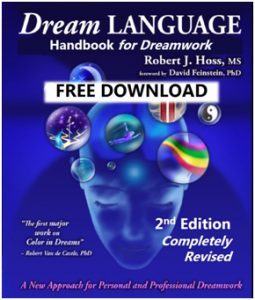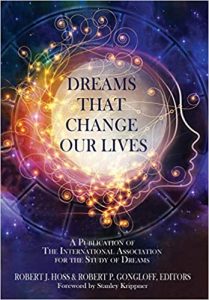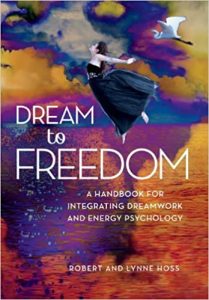The following procedures for understanding and working with your dreams are designed for dreamwork practitioners or self-help and can be adopted to clinical practice. They are not to be considered a replacement for therapy. These approaches are derived from a unique combination of Gestalt Therapy practices and Jungian theory as well as supportive studies from recent research on the neurology of dreaming. The color procedures are based on studies of the human emotional response to color. Note that these procedures are designed for personal exploration, such that the dreamer remains the ultimate authority on the meaning of the dream. Please refer to the IASD Ethics Statement to ensure ethical dreamwork practices .
Index
Quick Guide for Dreamwork (below)
- Dream Worksheet in PDF (updated 06/26/2023)
- Color Questionnaire in PDF (updated 03/08/2020)
- Scripted Role-Play (“6 magic questions”) in PDF
Dream Work Guide
This guide provides an in-depth approach that follows the natural way that a dream deals with emotionally important matters related to waking life situations. It takes you beyond simply understanding the dream – which is only the very first step in dreamwork. It is a full closure approach, which begins with understanding the dream narrative, then going deeper into the underlying emotional issues the dream and the dreamer (you) is dealing with, and finally exploring the dream for clues as to the natural way the dream was trying to resolve the problem; clues that you can apply in waking life. The approach is based on a mixture of Jungian psychology, Gestalt therapy, contemporary psychological theory (Ernest Hartmann MD among others) and recent findings from neurological studies on areas of the brain active in REM dreaming. Some of the theory and research supporting this approach is briefly outlined below, however you may refer to the books by Robert Hoss, Dream Language and Dream to Freedom, or the Articles button on this site for further detail.
The Transformative Dreamwork Protocol
This guide to the Transformative Dreamwork protocol, provides an in-depth approach designed to follow the natural way that a dream deals with emotionally important matters related to waking life situations. It takes you beyond simply understanding the dream – which is only the very first step in dreamwork. It is a full closure approach, which begins with understanding the dream narrative, then going deeper into the underlying emotional issues the dream and the dreamer is dealing with, and finally exploring the dream for clues as to the natural way the dream was trying to resolve the problem; clues that you can apply in waking life. The approach is based on a mixture of Jungian psychology, Gestalt therapy, contemporary psychological theory and recent findings from neurological studies on adaptive learning in dreams. For the theory and research supporting this approach, as well as illustrated examples, refer to the Psychology of Dreaming and Science of Dreaming tabs on this site or the books by Robert Hoss (Dream Language 2nd Edition, Dream to Freedom). Download the Dreamwork Worksheet and Color Questionnaire (links above).
Not all dreams are of an emotional problem-solving nature although most will provide insight by, at a minimum, picturing the emotional aspect of your waking life situation metaphorically. The protocol was therefore divided into three parts with multiple steps which can be individually applied as appropriate to the dream you are working with. By exploring the dream with as much of the protocol as practical, however, you will likely find that even the simplest of dreams, or even a single image, can provide you with a wealth of information and insight about the dream and the situation (outwardly and inwardly) that it is dealing with.
The protocol contains three parts. Don’t stop too early. The common mistake is thinking that the dreamwork is complete after the first “aha” which generally only makes a dream to life connection. At that point the dreamwork has only begun – the dream itself is working at a much deeper level and has so much more to offer so go on to the next part.
- Part #1 – What Life Situation is the Dream Dealing With? This phase begins after recording the dream, and what emotionally important situation is happening in your life at the time. The dream story is then explored using several tools to reveal what situation in your life the dream is dealing with. These tools explore the picture-metaphor, associations and memories represented in the dream imagery. Understanding the dream at this level generally only reveals what life situation your dream is dealing with but not how you might deal with it – there is much more dreamwork to pursue – so don’t stop here.
- Part #2 – Exploring Underlying Emotions: This phase explores the underlying emotional issues or conflicts contributing to your waling life situation. It uses two approaches for revealing the emotional content pictured by a dream element or image. A scripted role-play technique and the Color Questionnaire (see PDF download links above).
- Part#3 – Dream Guidance and Resolution: This phase explores how your dream (and your unconscious mind) it attempting to resolve the situation and how you might apply that insight in waking life. The dream structure along with four clues to revealing the guidance in your dream are explored. The resultant insight is checked out and explored as possible action steps.
Part #1 – Exploring Associations in the Dream Narrative:
Step #1 Recording the Dream
1a) Recall the Dream by closing your eyes before writing anything down, going back into the dream and trying to capture as much of it as you can before writing it down or recording it.
1b) Record it as if you are Reexperiencing it: it in the first person as if you are re-experiencing it (using “I am..” or “I see..” or “I feel..”). Keep any slips-of-the-tongue and spelling or phrasing mistakes – they might be important metaphors. Consider all the Elements: dream figures, objects, emotions, color, other descriptors etc.
1c) Separate the Segments: Look at scene shifts as separate segments each dealing with the same issue but from a different perspective, bringing in new associations or memories and introducing different resolution scenarios, perhaps learning something from the segment before. Worked on them later as separate but associated dreams.
1d) Give it a Title and Date it – an imaginative one that captures its essence, just a few words.
1e) Sketch the Dream – as if looking at a map from above. Optional but permits you to see relationships between dream figures and patterns and directions that provide important clues as to archetypal processes taking place. Sketch any odd imagery or imagery combinations.
Step#2 Record what is Happening in your Life at the Time:
It is important to not only record the dream properly, but to also record the emotional situations happening in your life at the time while it is still fresh. This is very important, particularly if you are keeping a journal, to record both so that you can look for dream patterns that relate to waking life patterns. Recall any emotionally impactful situations the day before, positive or negative and large or even minor, which created some emotional discomfort or annoyance, or that you did not want to deal with at the time.
Part 1 WHAT Life Situation is the Dream Dealing With
Step #3 – Dream to Life Comparison
The next step is to explore your personal associations with the various elements and imagery in the dream in order to relate the dream story to your waking life story. Although some persons or events from waking life may appear in the dream, the actual event that stimulated the dream rarely appears as it was experienced in waking life. Instead the dream captures and pictures the emotional impact or personal “meaning” of the waking life event in relation to your past experiences and inner model or self and reality – “the unconscious aspect of the conscious event” as Jung put it.
3a Dream Orientation: At the onset does the dream metaphorically picture some emotional situation in your waking life? Might it symbolically picture (figuratively or archetypally) the thing that is to be dealt with in order to resolve that situation (a Shadow issue; past event, trauma, associated factor or aspect
3b Metaphors in the Dream Story – Look for phrases, word-play and action themes in the dream story that sound like they also might describe something going on in your life at the time. Look for the initial scene of the dream to metaphorically picture an emotional situation in your life at the time.
3c Associations and Memories:
3d Rewrite the Dream Story and Relate to Your Life Story: Place the above associations into the dream narrative (in the margins perhaps) and read the new story. How it might relate in various ways to the events in your waking life?
Part #2 – Exploring Underlying Emotions
This part contains two approaches for exploring the underlying emotions pictured by the dream imagery, perhaps conflicted emotions that may have you stuck: 1) role-play; 2) and color work. As a primary approach to working with dream imagery, I recommend applying both role-play with color work (if color is recalled) to one or more key dream elements.
Step #4 – Scripted Role-Play (6 “Magic” Questions)
One of the most effective approaches to exploring the underlying emotional issues, conflicts and motivations, that the dream is dealing with, is to “give the dream a voice.” This is a scripted role-play approach I developed as a derivation of Gestalt role-play. My students lovingly termed it the “6 magic questions” since it seems to rapidly reveal underlying unexpressed emotions or emotional conflicts that are at the core of the situation the dream is dealing with.
Each element in the dream is a meaningful creation associated in some way with your life. You can choose to work on many, or just one or two which may be all you need to reveal the underlying emotional feelings or conflict the dream is dealing with. The best approach is to select images that curiously draw your attention. Work with as many as you wish to understand, but often just one may be all you need to reveal the underlying emotional conflict the dream is dealing with. Ernest Hartmann called it Central of Contextualizing image which contains the emotional state of the dreamer. It could but doesn’t have to be the imposing image, and sometimes the little inorganic ones in the background can contain the most information (Perl’s indicated that the more alienated fragments of the personality might appear as the least human imagery.
4a Pick a Dream Image or element that curiously draw your attention. To do this re-enter the dream at perhaps the most emotional part and look around the dream scene and pick an image ‘X’ (inanimate or animate thing or figure) that draws you to it – it doesn’t have to be the dominant image. You might pick a few and work on each one of them using this scripted role-play procedure.
4b Give the Image a Voice (scripted role-play or the “6 magic questions”): Close your eyes, go back into the dream and bring the dream image or figure ‘X’ into view. Now take 3 deep breaths and with each breath move into and “become” the image. Feel what it feels like in that role. Then speak as if you are the image in the first person, present tense, answering these 6 to 7 questions (best if someone asks and records the answers so you can stay in character):
1) Who or what are you, and how do you feel in that role: “I am …..”
Alternatively, if the dream image is a person you know from waking life, become that person and state: My most notable personality characteristics are …..”
2) As ‘X’, what is your purpose or function: My purpose is to …..”
3) As ‘X’ what do you like about what you are and what you do? “I like …..”
4) As ‘X’ what do you dislike about what you are and what you do? “I dislike …..”
5) As ‘X’ what do you fear the most, what is the worst thing that can happen to you? “I fear …..”.
6) As ‘X’ what do you desire the most? “What I desire most is to …..”
7) Dialog (optional): From the viewpoint of ‘X’ look around the dream and spot the dreamer (think about what they are doing in the dream). What do you want to tell them (first thing that comes to mind)?
4c Relate these Statements to Waking Life: Read the statements back to yourself – but this time not as if they are that dream image speaking but now as if they are you saying them about a situation or way you feel in your life. Do any of the statements describe a situation or feeling in your waking life? Focus on one specific situation when you felt that way and define your feelings at the time. Then review the above statements:
- Do the “I am” and “My purpose” statements sound like a role you feel you are playing in waking life?
- Do the “I like” versus “I dislike” statements sound similar to conflicting feelings, or an argument going on inside you, regarding a waking life situation?
- Do the “I fear” and “I desire” statements sound like fears and desires you have regarding that situation, perhaps fears and desires that feed the conflict?
- Does the statement from the dialog sound like it might be practical guidance?
- If the dream figure is a known person, focus on their personality characteristics and ask yourself, “Am I acting in some way like this person?” or better yet “How would they approach the situation I am dealing with?” (this may be an approach the dream is testing). If the person is acting abnormally or opposite to what they would in waking life, they could be representing a surprise or compensating element to be explored (seeing that personality characteristic from a different perspective).
Step #5 – Exploring Emotion in Dream Color
If the dream image you are working on contains color, or if the dream has some colors that stand out, then use the instructions below in conjunction with the tables 1 and 2 of the Color Questionnaire (download link above). The color tables list common human subliminal associations between color and emotion (based on research and color psychology literature) and are not the “meaning” of color but rather are intended to trigger your own emotional associations between the dream and your waking life feelings.
5a) Select the colored dream images to work on: the image you have been working with, or those colors you feel most drawn to or that stand out. It is best to work with something that is not a commonly colored object (like green grass), unless it stands out. Work with a colored image on which the color is optional (such as a red hat, a blue car, an orange dress). Also look for color pairing which might represent a conflict between emotions. Look for a grouping of the 4 primary colors – red, yellow, blue and green (if one color seems to be most active in the group of 4 or is obviously missing from the group, work on that color).
5b) Pick the color or color combinations in the tables that best match. Single Color: use table 1-to select the closest matching color or use table 2 if it is a color mixture. (ex: blue-green). Color Pair: Explore the possibility that the two colors might represent conflicting emotions by using table 1 on each color separately or table 2 for the pair – or – explore the possibility that the pairing/integration in table 2 might represent a path to or state of resolution (first match the dominant hue with the row, then the secondary color with the column).
5c) Read each statement as a question asking yourself: “Does this statement relate to a way I have felt recently or describe a situation in my waking life?” For color pairs, read both colors using table 1 and 2 to explore whether the two colors might represent two conflicted emotions or try table 2 to explore statements that might represent a possible conflict integration or resolution scenario.
5d) Relate to Waking Life: Pick the one or two statement(s) that create the strongest “aha” response or “connection,” that best relate to a waking life situation or conflict. Describe the situation, and the feelings at the time, in your own words. How does the color work add to your understanding of the dream as well as to your self-understanding?
Step #6 – Situation Summary
At this point you should have explored your personal associations with the dream, made various connections between your dream and waking life situation and hopefully identified some of the emotional issues or conflicts involved. So just write down your insights at this point: what emotional situation in your life does the dream appear to be dealing with and what are some of the underlying emotions or conflicts involved? The next phase will be to determine how the dream was attempting to resolve the situation so that you can use that insight and guidance to help you move forward.
(Option) Digging Deeper: If you want to explore the situation a bit deeper at this point try these hints:
- Try inserting the role-play and color information from Part 2 into the dream story in a way that further aligns it with your life story.
- Try to define what appears to be the conflict something like this: “I need or desire ___ because ___ but if I ___then I fear ___will happen”.
- Try exploring your past (traumatic event, childhood beliefs/teachings, source of a phobia, etc.) for the originating decision that created the present conflict – particularly if a person or event from the past was evident in the dream. Reflecting on the emotions revealed above, go back to one specific situation earlier in life, when you also felt that way. What happened, who was involved, and what decision did you make at the time? How does it relate to your situation today?
Part #3 – HOW is the Dream Attempting a Resolution?
At this point, you likely have a deeper understanding of how the dream story relates to your life story. You may also have become aware of some uncomfortable or painful emotions, fears and conflicts that are contributing to the situation. These are issues that you have been unable to consciously resolve – but which your unconscious and you dream is now dealing with. At this point, if issues have surfaced that seem highly emotionally charged and too difficult to deal with, then do not proceed further – such issues are beyond this simple self-help procedure. The procedure should not to be considered a substitute for therapy or professional help. If you feel ok about managing the insight so far then the next step is to understand how the dream (along with the vast wisdom and experience of the unconscious) is trying to resolve the situation.
Step #7 – Exploring the Dream Guidance
Re-orienting: Re-enter the dream and briefly review the dream story. With the information from the prior steps in mind, explore the structure of the dream story to understand whether and how the dream might be trying to resolve the problem. Did it contain any of the following: 1. A metaphoric “picture” of your waking situation; 2. Introduction of an alternative “what-if” solution/viewpoint or insight/guidance that caused your dream-self to change its viewpoint or actions (compensation or counterfactual). 3. Action that tested that alternative solution or viewpoint; 4. How did the dream end – was there an emotional reinforcement of the outcome (positive or negative). Was there any archetypal imagery present that pictured organizing or integrating processes taking place (see Psychology of Dreaming tab).
7a) Compensating Action: Did the dream Introduce an Alternative Viewpoint or Resolution Scenario?
- Guidance – did you experience a guiding figure or event (advice, action, discovery, new decision, written or verbal message)? Define the new direction or insight provided and how it changed your behavior or thinking in the dream.
- Surprise – did something surprise you (action/situation opposite to expectations; unexpected twist; sudden discovery or insight; odd imagery blend)? How did it differ from expectation or provide a different point of view and how did you respond?
7b) Test/Acceptance or Reversal – Did the dream story test the alternative scenario? Did your dream-self (or something representing you or your view) at some point make a decision or accept the guidance or reverse its thinking, viewpoint or action in the dream; what brought this about?
7c) Reinforcement: Positive or Negative Ending? Did the dream end positively or with a potentially positive direction to it – negatively (as in a warning) or inconclusively. If so what happened, or what did your dream-self do or refuse to do, that might have brought that ending about?
Compare to Life: Particularly if the dream ended positively, can you see any analogies between how the implied guidance or dream solution (change in viewpoint, attitude or direction or your dream-self) might be helpful as a solution to the situation in your waking life? If it ended negatively or inconclusively can you see an analogy between the non-effective actions or attitude of your dream self might be like that or your waking self.
Next: If this was revealing, Go to Step #9 for the Action steps. If not try Step #8, Active Imagination below.
Step #8 – Active Imagination (finish the dream)
Not all dreams have an obvious resolution scenario or guiding and compensating “message.” Most dreams don’t end positively which may be an indication that the dream did not resolve the problem but only made some attempts or tested one or more scenarios. Therefore, if the explorations in step 7 are nonobvious or if the dream does not seem to conclude, the dream can still be used as a platform to help create a resolution metaphor to guide thinking in how best to move forward.
8a) Review how the dream ends: Take a few deep breaths and re-enter and visualize yourself at the end of the dream and focus on your feelings at that point. Think back through the dream as to how you got to this point. Staying in touch with your feelings, what if anything are you wanting or trying to do at the end.
8b) New Ending: Continue to focus on your feeling as you visualize the ending of the dream. Now, without thinking about it, just letting the images flow and form by themselves, finish the dream with a new imagined ending that works out positively for you and perhaps those you are involved with in the dream.
8c) Waking Life Analogy: Once you have the new ending it is typically another metaphor as was the rest of the dream, but one hopefully related to a resolution. If there is a lot of missing detail as to how you got there, continue to let the imagery spontaneously form to fill in any specific actions or events must have occurred to bring it about. Think in general about ways that new metaphoric ending might be analogous to something that could be done in your waking life to resolve the situation or conflict the dream appears to be dealing with?
Step #9 – Action: Resolution and Next Steps
An important steps in dreamwork is to use the insight gained to help you make better decisions about how to manage or move forward with the situation the dream was dealing with – using the depth and breadth of your unconscious wisdom to help you in ways that the cognitive rational mind has not been able to. This involves creating a tangible solution statement from the metaphoric guidance and insight from the dream that might be analogous to a workable solution in waking life. The tough part is setting the ego biases aside that may influence and misinterpret the resolution the dream was attempting – so it is important to check it out (see below) before applying it.
Just as importantly, the dream or dream segment you are working on may not be focused on resolution – but rather simply revealing and putting the misconceptions of your waking ego into perspective – or revealing the unconscious aspect of a conscious event as Jung put it). So if this final “action” step appears to be leading nowhere don’t try to force out a solution.
9a) Define an Apparent Solution: If obvious resolution metaphors appear to be present in steps #7 and #8, then define (in specific terms) how they might represent a practical solution to your waking-life situation – that you can actually act on. Note: because these are usually metaphors they too may have to be translated as you would any dream element, using association, role-play and color tools (steps #3 to #5) to understand what the elements relate to.
9b) Check It Out: You must do an appropriateness check. Is it a healthy, practical, appropriate resolution that allows you to progress in a positive direction – or – does it go too far to be achievable or perhaps leave you stuck again? If it is not healthy or appropriate, do NOT pursue it.
9c) Next Steps: If it checks out positively, then what specific next step(s) can you take to bring it about? Imagine/picture yourself in the situation again and describe what you would do differently this time. Turn that into specific written “next steps” that you can actually try out.
9d) Reminder Image: It can be helpful to take away some simple visual reminder of the new solution in the event a similar situation is experienced in the future. From the resolved or positive ending (actual or visualized), select a “resolution” image to remind you of your new solution.






